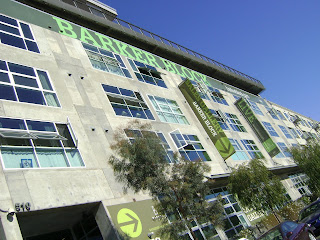The highlight of the California Science Center is a 24-foot-long transparent tunnel through a 188,000-gallon tank that puts you face to face with 1,500 horn sharks, swell sharks, giant sea bass, wolf eels, bat rays and other fish swimming in a kelp forest. There are 11 ecosystems highlighted, with lots of hands on exhibits at this museum. Seems like a cool place to take kids (and there were plenty of them there).

 We actualy went there to see the 'Mummies of the World', a limited time exhibit. It is a previously unseen collection of 150 mummified humans, animals and artifacts from over 6,000 years ago to the 11th century. Yeah, it was kind of creepy. But for someone who can't tolerate any type of gore, blood, or anything spooky, I actually withstood it quite well. It was pretty crowded, so perhaps that helped. I'm sure if I was alone in there, I would have high-tailed it outta there pretty quick! It was interesting to read about each mummy and where they came from. We then saw the IMAx movie Mummies 3D: Secrets of the Pharaohs about the royal tombs of Egypt, which was really cool. It is hard to fathom such ancient history.
We actualy went there to see the 'Mummies of the World', a limited time exhibit. It is a previously unseen collection of 150 mummified humans, animals and artifacts from over 6,000 years ago to the 11th century. Yeah, it was kind of creepy. But for someone who can't tolerate any type of gore, blood, or anything spooky, I actually withstood it quite well. It was pretty crowded, so perhaps that helped. I'm sure if I was alone in there, I would have high-tailed it outta there pretty quick! It was interesting to read about each mummy and where they came from. We then saw the IMAx movie Mummies 3D: Secrets of the Pharaohs about the royal tombs of Egypt, which was really cool. It is hard to fathom such ancient history. 

The E. Hadley Stuart, Jr. Hall of Gems and Minerals displays more than 2000 spectacular specimens. I found this particularly interesting seeing all the stones in thier raw form, many which I use in my jewelry designs. Chad was so patient as I looked at each of the 2000+ stones. I loved this exhibit!



 A five-carat, blood-red diamond is one of just three in existence, and it is on display at the Natural History Museum in Los Angeles. The Kazanjian Red has quite a history. It was discovered in South Africa in 1927, stolen out of the Netherlands by the Nazis during World War II and recovered by American soldiers. The diamond is on loan from the Kazanjian Foundation, which raised scholarships for needy students.
A five-carat, blood-red diamond is one of just three in existence, and it is on display at the Natural History Museum in Los Angeles. The Kazanjian Red has quite a history. It was discovered in South Africa in 1927, stolen out of the Netherlands by the Nazis during World War II and recovered by American soldiers. The diamond is on loan from the Kazanjian Foundation, which raised scholarships for needy students.






 Whew! The next day, there was a bead and gem show aboard
Whew! The next day, there was a bead and gem show aboard 
























 My favorite are box clasps made with vintage buttons or intaglios. Box clasps are two-piece clasps that open when you push down on the exterior lever of a wedge-shaped piece of metal (tongue), compressing it so that it slides out of the opening. Push it back in the groove and it clicks into place.
My favorite are box clasps made with vintage buttons or intaglios. Box clasps are two-piece clasps that open when you push down on the exterior lever of a wedge-shaped piece of metal (tongue), compressing it so that it slides out of the opening. Push it back in the groove and it clicks into place.




















